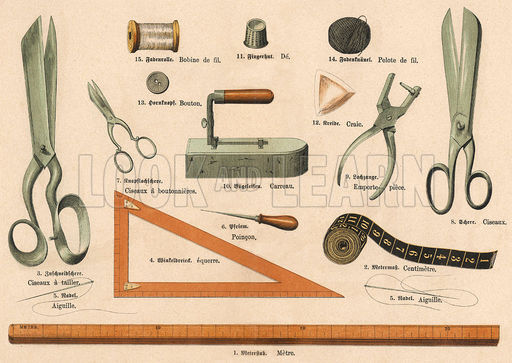Historical Pattern Making Tools, Tailoring Tools

Tailors’ tools used by an American custom tailor in early 1900
Tailors’ tools used by a custom tailor in Duluth. C. Paul Nelson emigrated to the U.S. from Sweden with his four daughters in early 1900. Though tailoring has traditionally been a craft dominated by men, two of Nelson’s daughters – Sophie and Hanna worked as “tailoresses.” According to the 1910 census, Sophie, Hanna and their father were working in Duluth. In 1930 both Sophie and Paul Nelson were still working – Paul as a coat-maker and Sophie as a vest-maker. In the 1900 Minneapolis City Directory, vest making was a woman’s occupation. Six women listed their occupation as vest-maker. Often women worked on lighter weight garments or women’s tailored clothing in a dressmaking shop rather than a tailor’s shop. In this same city directory, of the 724 tailors listed, 89 were women.
The word "tailor" dated back to 1297
The word “tailoring” means “the art of cutting” in many languages, and indeed, it is the cut of the fabric that makes a garment fit the body to perfection. A tailor’s skill in measuring an individual’s body and making a pattern from those measurements determines how well a garment fits. Tailors made clothes for both men and women. Shirts, stockings, hats, and capes were ready made, but coats, weskits, breeches, stays, and gowns were custom made for individuals.
Historical Sewing Machine and Sewing Needles

Early sewing needles were made from bone, wood, or natural needles taken from plants as Native Americans did with the agave plant. The earliest verified sewing needles made from iron date back to the third century B.C.E. and were found in what is now Germany. Chinese archaeologists report finding a complete set of iron sewing needles and thimbles in a tomb dating from the Han Dynasty (202 BC-AD 220) in China. This is the earliest known example of a thimble in history. The thimble was developed to assist early sewers to push needles through thick hides and furs, and was first made from bone, wood, leather, sometimes glass and porcelain. Later thimbles began to be made from metal, and before the 18th century dimples in a thimble had to be punched into it by hand. The thimble also became an object of beauty with thimbles made from precious and semi-precious stones, and precious metals.
The first thread was made from plant fibers and animal sinew, which was used to sew together hides and furs for clothing, blankets and shelter. Later it was found that fibers from plants and animals could be spun together to make thread. The ancient Egyptians made thread by spinning these fibers together, and devised methods of dying the thread using berries and plant matter. In China and Japan, silk fibers taken from the cocoon of the silk worm was spun to make very fine thread.
For most of the history of sewing, it was done by hand. From the simplest stitches to ornate decorative work was done with a needle, thread and a steady hand. It remained so until the first patent for a machine that "emulated hand sewing" in 1790 in England. It is not known whether there ever was a machine built from the 1790 patent.
The first functioning sewing machine was issued a patent to Barthelemy Thimonnier in France in 1830. It used a single thread and a hooked needle to make a chain stitch similar to the one used in hand embroidery. The inventor was nearly killed when enraged French tailors rioted and burned down his garment factory because they feared the machine would cause unemployment. In 1846 the American Elias Howe was issued a patent for his machine, but the mass production of the machines did not happen until the 1850's when Isaac Singer built the first truly successful sewing machine. With needle, thread, thimble and machine, the art and craft of it has not only formed items for our use and comfort. Sewing has helped form civilization itself. |



